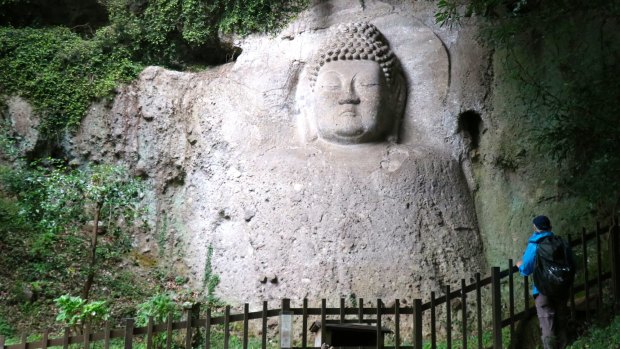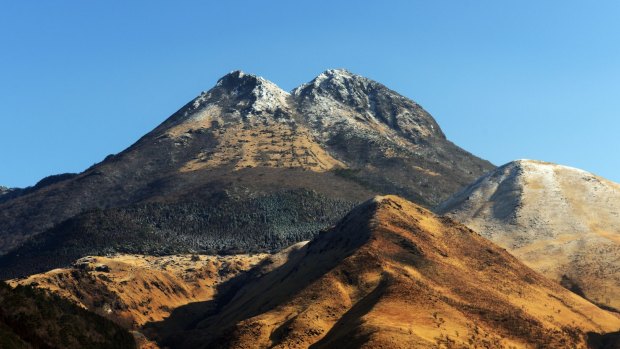This was published 5 years ago
Japan, Kyushu: Hike Kunisaki Peninsula's sacred mountain hike

Japan's largest Buddhist rock carvings, near Kumano Shrine.
There's no one else around. Everything is green: the ground, carpeted with cedar and cypress fronds, the stone stupas beside the track clothed in lichen and the mossy trunks of the towering trees we pass. A deer whistles. Then the silence returns.
Emerging from the forest, we climb rocky stegosaurus ridges with the aid of fixed ropes, chains and steel ladders bolted to vertical walls like a Japanese via ferrata and look down on hamlets and rice fields nestled in small, secluded valleys.
Isolation and adventure, that's what this 10-day Kunisaki Trek in Kyushu is all about. Although we carry only daypacks, it's a real boots-and-all hike in a "very forgotten place", as our guide Takuya describes the Kunisaki Peninsula on our first day, making it unlike more popular walks in other parts of Japan.

Mount Yufu, a dormant volcano in Oita prefecture, Kyushu.Credit: Alamy
Our party of five – Takuya, a 60-something couple from Oregon, an entrepreneur from Shanghai and me – meet at Fukuoka's busy Hakata station to catch a Sonic Express train heading east. It's only a 90-minute trip, but our destination is a world away from Kyushu's largest city.
Bulging from the north-east coast, the Kunisaki Peninsula consists of a central dormant volcano, the 721-metre Mount Futago, with forested ridges radiating from it in all directions. It's also separated from the rest of Kyushu, and Japan, by a line of mountains, which made it the perfect refuge for Buddhist monks seeking solitude in the 8th century.
The leader of this peaceful migration was the monk Ninmon, who founded a distinctive Buddhist-Shinto cult imbued with elements of pre-religious mountain worship, called Rokugo Manzan. Dozens of temples were built and legend has it Ninmon carved more than 60,000 stone Buddhas along the paths between them, one for every Chinese character of the Lotus Sutra, one of the most influential sutras for Mahayana Buddhism. For Rokugo Manzan monks, walking in Kunisaki was as good as reciting their most sacred text.
But these mountain trails were mostly off-limits to the public until 2004, when Walk Japan ran its first Kunisaki Trek. It was the brainchild of Paul Christie, a former television producer from Britain who joined Walk Japan in 1997 as a guide and is now its chief executive. When he moved to rural Kunisaki in 2002 in search of a simpler life, moving the company's head office into a restored farmhouse there, he soon realised the area's potential.
"The Kunisaki Peninsula is little known, even in Japan," he says. "Its relative underdevelopment has allowed it to retain a beauty and simplicity of an older time." Walk Japan is the only tour operator offering this hike, a roughly clockwise loop that cobbles together the best bits of a trail first walked by monks 1300 years ago.
As soft rain falls, our first walk begins from a deserted carpark. It's an inauspicious start and an indication of just how off-the-beaten-track we are, as is our first destination: an unassuming forest shrine at the top of a 654-metre peak called Omoto-san. It's one of the most sacred mountains in Kyushu, but you wouldn't know it. With no road access, few people visit, Takuya says.
After paying our respects – by ringing the bell, bowing twice, clapping twice and bowing again – we walk, passing several headless Buddha statues. "Have you seen The Last Samurai?" Takuya asks, before using the 2003 epic to explain why people chopped the heads off Buddhist statues all over the country in the late 1800s. It was the end of the samurai-ruled Edo period and they wanted to show allegiance to the new emperor, believed to be descended from Shinto gods (the samurai were Zen Buddhist).
At the bottom of the mountain we reach Usa Shrine, the starting point for monks making the Kunisaki pilgrimage. A sprawling Buddhist-Shinto complex built in the 8th century and one of Japan's National Treasures, it's waterfalls, lotus ponds and towering camphor and maple trees stand shoulder-to-shoulder with ornate temples and bright-orange torii gates. Gentle rain. The sound of a stream. Just being there is like a haiku.
Each night, in a local inn, simple things connect us to traditional Japanese life: the sweet straw smell of tatami mats, sleeping on futons, sliding shoji screens and, best of all, the onsen. Could there be a better way to end a day of hiking than by soaking in a natural hot spring bath? Afterwards, we meet in the restaurant of our ryokan in our cotton yukata, making dinner feel like a pyjama party (with yukata provided, there's no need to pack evening wear on this trip).
And the food! That was the best dinner, I think every night. Then the next night's dinner tops it. One of my favourites is a 12-dish extravaganza featuring local prawns, octopus, sea bream sashimi, various seaweeds, fish soup and whelk (sea snails), with green tea and chestnut brandy cake for dessert.
The lunches are also a delight: picnics with home-made bento boxes, freshly made udon in a local restaurant and, on day three, a country-style buffet in converted stables where we linger over coffee on sheepskin-covered chairs around a wooden table with a built-in charcoal stove.
Monks still walk in Kunisaki, but only every 10 years (the next pilgrimage is in 2020), so we have the trails to ourselves, except for a few locals we meet along the way. Walk Japan runs these trips partly to give back to local communities, so these encounters are an integral part of the Kunisaki experience. One morning we have tea with a 75-year-old grandmother who has lived on the peninsula since she was a girl. A local ceramic artist and former forester, Kenji, joins us some days, teaching us about the trees. We stop and chat to farmers and Shinto priests.
Before breakfast on day four, we have a chance to meditate in a 900-year-old temple, the oldest wooden structure in Kyushu, with the resident Zen monk. Eyes open, hands in our laps, we sit together on the ancient wooden floor, counting our breaths and listening to the howling wind outside.
If this walk has a climax, it is on day five when a ridge walk brings us to a "bridge of mumiyo". There are three on the peninsula: narrow stone bridges that are short but exposed, built over chasms to test one's attachment to life; no attachment is a sure sign you're close to enlightenment, apparently. We all cross safely, with plenty of attachment to our lives, reassured by Kenji's words: there's a local belief that only "evil people" fall.
Every day we see evidence of Kunisaki's spiritual side. Not just shrines and temples, but clusters of moss-covered monk statues so camouflaged we almost don't see them, two enormous Buddha figures carved from a rock wall like a Japanese Mount Rushmore and twin knee-high deities Ku Kai ("sky ocean") and Dainichi ("big sun") who sit beside the track, in niches carved from boulders, at the top of one mountain. It's an odd feeling to have sweated up to a lonely peak only to find someone has been there before you, 1000 years earlier.
On day six, we pass a sculpture of a different kind: a cast-iron man on a ridge, gazing across the Inland Sea to Honshu. Created by British artist Antony Gormley, best known for his Angel of the North in northern England, it's one of 100 solitary figures celebrating stillness in remote locations around the world.
There's a change of pace when we catch a ferry to Himeshima, a small island off the northern tip of the peninsula. While the others climb to its highest point, I walk to its lowest, a golden beach at the base of the peak. Even on this warm, blue-sky day, there's not a soul around. Drying off after a swim, I look across the water and get a fresh take on Kunisaki's ruggedness: the entire skyline is a hazy ECG of the ridges we've been walking up and over all week.
Back on the mainland, we hike into the clouds on our last day, to the 1584-metre summit of Mount Yufu, a dormant volcano lording over the little onsen town of Yufuin, where we spend our last two nights. We're no longer on the peninsula, and it shows. Returning to our ryokan after the climb, we join a river of Korean and Chinese tourists flowing down the main street, past souvenir shops and cafes, which highlights just how special Kunisaki is and how far the rest of Japan has drifted from its roots in this long-forgotten part of the country.
"There is indeed something spiritual in this place," says Tom Cruise's character in The Last Samurai. "And though it may forever be obscure to me, I cannot but be aware of it." The Kunisaki Trek reconnects you with that timeless Japan, one that's wild and peaceful, simple and soulful, where stone monks watch over you and the deer really do whistle.
FIVE MORE TREKS IN JAPAN
KUMANO KODO
A UNESCO-listed pilgrimage route, known as Japan's Camino, that follows the path taken by emperors from Kyoto and Nara to Shinto and Buddhist sites in the Kii Mountains. See caminoways.com
NAKASENDO WAY
One of the most popular walks in Japan, this ancient 540-kilometre trail between Tokyo and Kyoto combines village-to-village sections with short train trips. See nakasendoway.com
SHIKOKU PILGRIMAGE
This 1200-kilometre trek linking 88 Buddhist temples all over the island of Shikoku is a tough one, but divided into sections. You can do it as a self-guided walk. See okujapan.com
HIKE HOKKAIDO
It's all about nature on this nine-day hike through the national parks and volcanic areas of Japan's sparsely populated northern island. See mountainhikingholidays.com
CLIMB MOUNT FUJI
It takes 8-10 hours to reach the summit of Japan's highest peak (3776 metres) and there are four routes, open July to September, so they can get crowded. Try to avoid weekends and public holidays. See fujisan-climb.jp
TRIP NOTES
Louise Southerden travelled courtesy of Walk Japan.
MORE
FLY
Cathay Pacific flies daily to Fukuoka via Hong Kong from Sydney, Melbourne, Brisbane, Adelaide and Perth. See cathaypacific.com
HIKE
Ten-day Kunisaki Treks run between April and June and October-November and cost from ¥428,000 including accommodation, transport, all meals and guide. See walkjapan.com
Sign up for the Traveller Deals newsletter
Get exclusive travel deals delivered straight to your inbox. Sign up now.